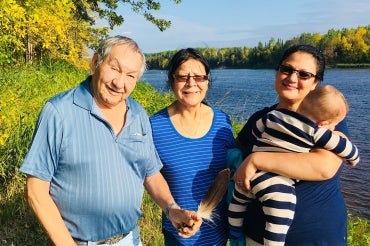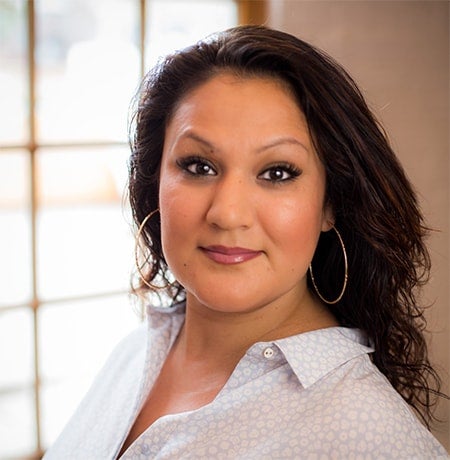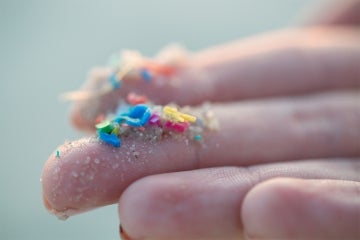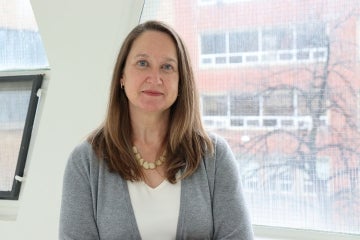Decolonizing the museum: U of T graduate student looks at ways of honouring Indigenous artifacts

Published: December 8, 2017
Museums with Indigenous ancestral objects on display should consider how they’re teaching the public about those artifacts and the people who once used them, says Audrey Rochette, a University of Toronto graduate student whose research focuses on museums and colonization.
 “We’re people that come from a rich history of oratory," says Rochette (pictured left), a master’s student in the department for the study of religion in the Faculty of Arts & Science and a member of Whitesand First Nation. "And when you go to museums, you look at things and there’s nobody there to tell you these fantastic stories about them.”
“We’re people that come from a rich history of oratory," says Rochette (pictured left), a master’s student in the department for the study of religion in the Faculty of Arts & Science and a member of Whitesand First Nation. "And when you go to museums, you look at things and there’s nobody there to tell you these fantastic stories about them.”
As a docent at the Royal Ontario Museum's major Anishinaabeg Art & Power exhibit that ran from June to November, Rochette says she got to share some of those stories. And as she guided visitors through Woodland School paintings, beadwork, bandolier bags and other works of art from the past two centuries, she says she also made observations for her master's research, looking at ways in which the ROM is incorporating Indigenous knowledges and voices into its programming.
Arni Brownstone, the curator of Anishinaabeg: Art & Power, says hiring Indigenous docents like Rochette was just one way the ROM tried to include Indigenous voices in the exhibition. He created the exhibit with Anishinaabe guest curator Saul Williams, a painter and Woodlands School of art member from North Caribou Lake First Nation, and historian Alan Corbiere from M'Chigeeng First Nation on Manitoulin Island.
Brownstone, who has been at the ROM since the 1970s, says the museum has created the Indigenous Advisory Circle, which meets to talk about ways of improving the ROM's relationship to First Peoples, and is hiring Indigenous knowledge resource teachers, curators and staff.
Rochette says she has been invited to sit on the ROM's roundtables about indigenizing its programs.
“They're working towards decolonizing their space and they’re very open to how that looks and how that can be done,” she says.
To ground her research, Rochette says she went looking for a comparative museum model, a place that had Indigenous artifacts exhibited in traditional ways. She found Kay-Nah-Chi-Wah-Nung Historical Centre in Rainy River First Nation – an Indigenous-operated historic site that Rochette says teaches Canadians about the rich history of its First Nations communities and burial grounds.
Designated as a national historic site in 1970, Kay-Nah-Chi-Wah-Nung – also known as “the Place of the Long Rapids” – sits on the banks of Rainy River, where Indigenous people lived and gathered for thousands of years. It was also a continental trading hub for Ojibway and other First Peoples.
“It’s a magical place and I can’t explain to you enough about how peaceful and how spiritual this place is,” says Rochette.
She took a first trip to introduce herself to the community, wanting to be transparent about what she was trying to achieve by researching their museum.
“You can’t make people talk to you, and say, ‘you’re going to share all the stuff.’ That’s not the way it works in Indigenous communities and as a native person I know that,” says Rochette. “I had to be there and build trust and let them know about my heart and my intentions.”
Read more about Audrey Rochette, 2016's outstanding Indigenous student of the year
When she returned to Toronto, it wasn't long before Rainy River Elders invited her to come back to take part in traditional ceremonies on the land. She says an Elder told her that if she wanted to talk about Rainy River, she needed to learn more about it.
To fund the trip, Rochette received a grant – the Indigenous Travel Award, from S.A.G.E., a group at U of T that supports graduate students engaged in Indigenous research. For five days she listened to stories in Ojibway and participated in traditional ceremonies, visited a healing lodge and sacred burial mounds.
“It really pumped up my own spirit and I felt stuck academically. I felt thin and worn down. To be a part of my Ojibway culture, and have all this knowledge shared with you, it restored my mind, body and spirit. I am incredibly grateful."
She says learning about Rainy River in a traditional, immersive way has given her ideas about how museums might reconsider their approach to teaching about Indigenous objects and cultures.
Kay-Nah-Chi-Wah-Nung consults with community Elders and holds roundtables to determine how best to curate and present objects and ideas. They also label objects with the Anishinaabemowin language, she says. “I would love to see at the ROM and other museums use Indigenous languages throughout their exhibits to honour the ancestral objects.”
Rochette says she’s hoping to return to Rainy River First Nation to spend more time at Kay-Nah-Chi-Wah-Nung before she completes her master’s thesis next year.



